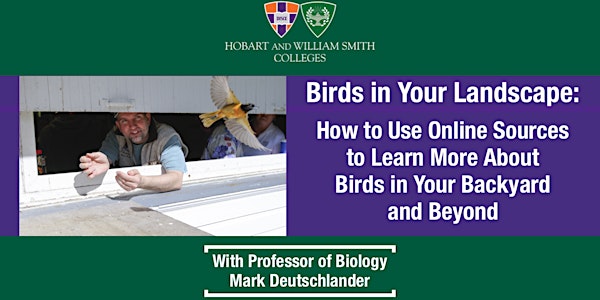
Birds in Your Landscape: How to Use Online Source to Learn More About Birds
Birds in Your Landscape: How to Use Online Sources to Learn More About Birds in Your Backyard and Beyond
Date and time
Location
Online
About this event
Join us LIVE on zoom for a conversation with Mark Deutschlander Professor of Biology at the Colleges about birds in our Landscape.
Monday, June 15
11:30 a.m.
Birds are an apparent and familiar part of our landscapes, whether hiking in a national forest or spending time in our own backyards or neighborhoods. From ‘pristine’, natural areas to the most urban settings, birds are ubiquitous. Birds can connect us with nature, and they serve as sentinels for the health of the environment.
Ornithology has benefited immensely from data collected by citizen scientists who enjoy watching birds. Citizen science data has help ornithologists learn so much about geographical distributions and population trends of birds, and advances in Internet and cellular capabilities have led to huge increases in ways that citizens can contribute to our understanding of birds. These population trends can help us understand the impact humans have on the environment, including urbanization, pesticide use, pollution, climate change, and more.
Prof. Deutschlander recently taught his Maymester course, Birds in Our Landscape, remotely. Typically, a field course taught in the Finger Lakes region, Mark will share with you how teaching and learning about birds can be adapted to remote learning and he will tell you about opportunities for anyone to learn about birds in their landscape and contribute to science through online resources, such as eBird. During the pandemic, nature activities have been popular outlet for rest and relaxation. Birding is a hobby that anyone can enjoy anywhere, and it’s easy to contribute to ornithology through your observations.
Prof. Deutschlander’s research focuses on migration in songbirds (i.e., warblers, sparrows and thrushes). He studies how birds use environmental cues (e.g. celestial, magnetic) to orient and navigate, and he studies how the energetic condition of birds impact their decision about migration. Much of his work is conducted at the Braddock Bay Bird Observatory, on the south shore of Lake Ontario, and the Colleges’ Hanley Nature Preserve. Mark has served as President of the Wilson Ornithological Society, the second oldest and second large, society devoted to avian research in North America.
Please register to be provided with the zoom participation information.
Photo Credit: Kevin Colton
A Prothonotary Warbler is spotted along the northeastern edge of the refuge. This species draws a lot of attention, as it’s rarely observed in Upstate New York.
For more information email alumrelations@hws.edu